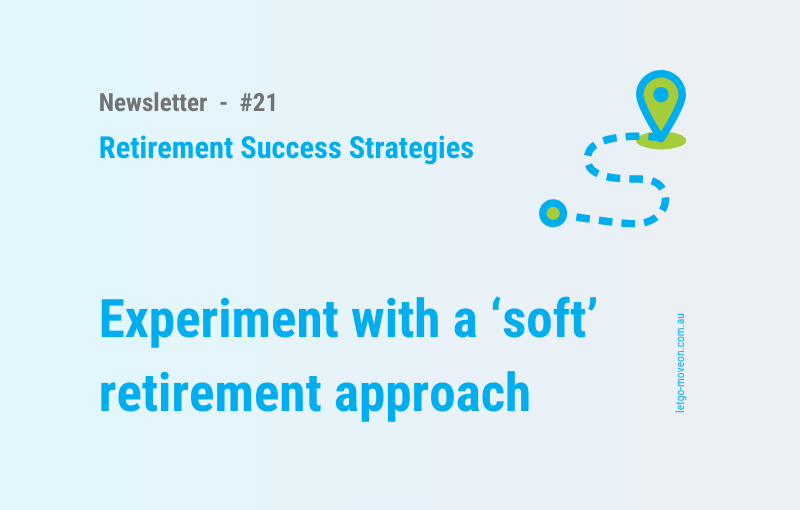Why would we choose a ‘Soft Retirement’ approach?
In recent years, there has been a noticeable shift in how we talk about retirement.
More and more, in personal conversations with people approaching or living in retirement – and in discussions among retirement experts – there is a move away from seeing retirement as a single, clear-cut, ‘hard’ event.
Instead, it’s becoming a phase of life to be shaped intentionally and flexibly.
Andrew Middleton’s concept of “soft retirement” fits into this evolving conversation.
(Sources: Middleton’s interview on Bec Wilson’s podcast, his ‘Short course on re-thinking retirement’ – download via his website)
While not entirely new or unique, the ‘soft’ retirement approach brings together fresh insights and practical tips for navigating this transition.
Rather than viewing retirement as a hard stop, Middleton advocates for a gentler, more adaptable approach.
These are some of the ‘soft retirement’ principles he suggests:
-
- Continued contribution in flexible ways
- Redefining work as a source of joy
- Staying healthy and financially prepared
- Prioritising connection and meaning
- Test-driving new roles before fully committing
8 practical ‘soft’ retirement strategies to pick from
I compiled a selection of 8 practical strategies based on Middleton’s approach, each with action steps and practical examples, so we can start – if we want – shaping our own soft retirement.
8 strategies – that sounds like a lot, but don’t worry: Not every strategy will resonate with you.
Just pick the one or two most appealing suggestions and use them to refine the design of your ideal retirement life.
#1 – Test-Drive new roles and interests
Action step: List 3 ‘dream jobs’ or activities you have never tried. Research local opportunities to volunteer, freelance, or take part-time roles.
Practical example:
Middleton experimented with various new roles, including wedding registrar and videographer. Some he loved, others he didn’t. You could test-drive, for example, being a museum guide, barista, or yoga instructor for a season. Other ideas?
#2 – Reframe work as play and purpose
Action step: Write down ways you can turn a hobby or interest into occasional paid work or a community contribution.
Practical example:
A retired teacher might start tutoring English online two mornings a week, blending income with enjoyment. A hobby baker might decide to sell pastries at a weekend market for fun and to connect with others.
#3 – Build a “Portfolio Life”
Action step: Create a mind map of activities – paid, volunteer, creative, leisure – that you would enjoy combining in your weekly routine.
Practical example:
A friend of mine splits her week between dog-walking for a neighbour, mentoring young professionals, and watercolour painting. Each adds variety and purpose without full-time commitment.
#4 – Prioritise health as an enabler
Action step: Schedule a health check-up and commit to one new physical activity this month.
Practical example:
Middleton began Pilates and treadmill workouts after a doctor’s warning. You might consider joining a walking group, trying aqua aerobics, or starting daily stretching to boost your vitality.
#5 – Plan financially for freedom and flexibility
Action step: Review your current financial position and identify how much you need to cover basics so additional earnings can feel like a ‘bonus.’
Practical example:
A couple calculated that their pensions cover essentials, giving them freedom to launch a small online shop without pressure for high profits.
#6 – Nurture and expand relationships
Action step: Reach out to 2 old friends and schedule a catch-up. Join a local group (such as a hobby, fitness, or volunteering group) this month.
Practical example:
Middleton emphasises the importance of avoiding isolation by forging intergenerational connections – consider joining a book club that welcomes all ages or volunteering in schools.
#7 – Keep learning and growing
Action step: Enrol in one short online or community course that sparks your curiosity.
Practical example:
Consider trying photography, digital marketing, or learning a foreign language. I know a retiree who took a videography course and started helping local businesses with promo videos part-time.
#8 – Live with intention and gratitude
Action step: Start a daily gratitude practice by noting 3 things you appreciate each morning. Pair this with setting one small intention for the day.
Practical example:
Middleton found joy in small daily rituals. You might decide, ‘Today I’ll walk in the park and call my sister,’ giving your day from the start an intentional direction.
Retirement is about stepping into the next version of our lives.
Middleton’s soft retirement reframes ageing not as decline, but as expansion.
I agree.
If we choose, we can make our retirement life as rich and dynamic as any other stage of life.
We can intentionally decide to step into roles that are lighter, more playful, and more aligned with who we are and what we value most.
What do you think?

